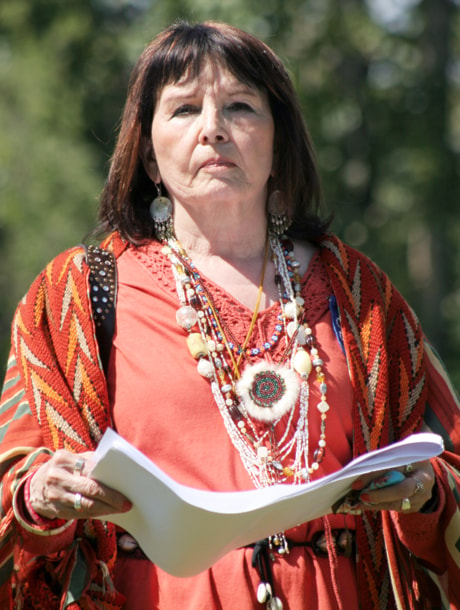FORT NORMANDEAU — So many children escaped and simply disappeared.
Parents who hadn’t seen their children came to pick them up for the summer, only to learn that they had died in school — or run away.
How could any parent live with that pain, asked Theresa “Corky” Jonasson, one of a crowd of over 200 people who gathered here on Wednesday to honour the hundreds of children removed from their families and placed in classes at the Red Deer Industrial School. Located across the river from the fort, the residential school had been funded by the Canadian government and operated from 1893 to 1919 by the Methodist Church, later amalgamated into the United Church of Canada.
“There’s a long history in my family of the residential school and its effects,” said Jonasson, recounting how children were taken to schools as far from their homes as possible to discourage them from running away. Many of those who did were never seen again.
It was especially fitting to see First Nations drummers leading ceremonies and speaking in their own tongues, activities that were forbidden to the children who were placed in the school, said Jonasson.
Wednesday’s celebration opened with prayers and pipe ceremonies leading into reading the names of all of the children who had been brought to the school.
A small graveyard lies nears the residential school grounds. At least twelve people are buried there and some of them were students.
The celebration should serve to put the souls of those children to rest and give surviving family members some peace, said Justice Murray Sinclair, chair of the Truth and Reconciliation Commission, appointed in 2008.
The three members of the committee, all present for the ceremony, are researching the history of residential schools and will recommend ways to ease the suffering of survivors, including the children and grandchildren of those who were placed in the schools, said Sinclair.
A study has been commissioned to find out what happened to the children, including finding burial locations.
“We are very committed to the issue of the missing children — children who went to residential schools and never came home. It’s important for us to uncover the truth.”
Estimating that residential schools had a devastating impact on seven generations of people, Sinclair said it could take seven more generations for descendants to put those memories to rest.
United Church of Canada Moderator Mardi Tindal, in her address to the group, said her heart breaks at the thought of the damage done over generations.
“The churches, including my church, were among those responsible for your pain. We were, and are, twisted by pain inflicted in the name of love as well,” said Tindal.
“You inspire us with your courage and your spirit . . . and you encourage other communities, as well, to imagine and envision a healed nation,” she said.
A number of the people attending the ceremony said they had been unaware of the school at Red Deer and were surprised to find familiar names among those the elders read as committee members passed out tokens in their names to family members.
Some families took as many as 50 tokens home with them, said Ermineskin member Richard Lightning, emcee and a key organizer for the celebration.
The tokens — small stones sewn into brightly coloured cloth — were made by elders from Saddle Lake, from which a large proportion of the Red Deer school’s children had been taken, he said.
Darcy Linklater, one of five people who came from the Nelson House First Nation in Manitoba, said he only learned a week ago that children from his community had been taken to Red Deer.
Linklater said he felt saddened and angry that those children were never brought home, vowing that their bodies be repatriated to Nelson House with the costs to be borne by the church and the federal government.
Saddle Lake member Leona Cardinal (nee Half) said she had no idea that members of her family had been taken to Red Deer, until she started to hear their names, including that of her grandfather.
Now more than 50 years old, Cardinal said she is just beginning to learn how much of her family’s history had gone missing.
bkossowan@www.reddeeradvocate.com
